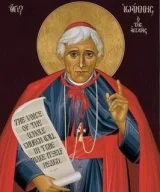(posted by David Murphy, member of the Personal Ordinariate of Our Lady of Walsingham)
After reading the two articles by Dame Joanna Bogle DSG and Father Matthew Pittam OLW, one might be excused for concluding that the Ordinariate after five years is failing in the basic task of uniting Anglo-Catholicism with the See of Peter and is only succeeding in those areas where it has ‘usurped’ parishes and other fields of activity from the dioceses.
Both of these conclusions are short-sighted if not totally incorrect. The Apostolic Constitution Anglicanorum coetibus was promulgated by Pope Benedict XVI and the Ordinariates were set up, not as an act of proselytism with the subversive motive of wooing Anglo-Catholics away from the Anglican Church, but as a response to those Anglicans who were already knocking at the doors of the Vatican requesting reception into the Church. Many, even those in the Catholic media, have erroneously assumed that the former was in fact the ecumenical project of which the Constitution speaks and even belittle Pope Benedict in the process, grinning smugly at the concept that true ecumenism might be construed as conversion of all Protestants (and Orthodox maybe too?) to Catholicism. This is to totally misunderstand the Pope emeritus.
The conversion of thousands of Anglicans, causing them to seek full communion with the See of Rome, had taken place long before the Apostolic Constitution and is not to be construed as the mission of the Ordinariates. Some of us may wonder why and deeply regret that only a relatively small number of our fellow Anglicans actually joined the Ordinariates – life would have been considerably easier for us if indeed seas of laypeople had been received (at least to match the number of priests) and the vast majority of Ordinariate communities had been large enough to form a fully-functioning parish and support their own priest from Day One. We now know that that was not to be the case and we must make provisions for the situation in which we actually find ourselves – more of that in Part 2.
No, the conversion which Anglicanorum coetibus reinforced was a conversion within the Church of Christ, and more specifically within the Roman Catholic Church. In one particularly decisive way it continued and set forth the aggiornamento (Newman’s development of doctrine) of the Second Vatican Council – and this is the true ecumenism of the Ordinariates. In the Dogmatic Constitution on the Church Lumen gentium the Council recognised that the single Church of Christ, which we profess in the Creed as one, holy, catholic and apostolic “subsists in the Catholic Church, which is governed by the successor of Peter and by the Bishops in communion with him. Nevertheless, many elements of sanctification and of truth are found outside her visible confines. Since these are gifts properly belonging to the Church of Christ, they are forces impelling towards Catholic unity” (LG8) and went on to develop these ideas in the Decree on Ecumenism. It is particularly significant that it is precisely this quotation from Lumen Gentium that Pope Benedict includes in his preamble to the Apostolic Constitution. The word “nevertheless” is especially noteworthy. The fact that the Church of Christ subsists in the Catholic Church does not in any way exclude the equally important fact that she does not have a monopoly on sanctification and truth or, as LG puts it, that elements thereof are to be “found outside her visible confines”, that these “gifts properly belonging to the Church of Christ” are “forces impelling towards Catholic unity”.
Benedict’s ecumenism is therefore the incorporation of these gifts into the Church, implying the opening of the Church to receive them. This is the first time that a whole patrimony of spirituality, liturgy, pastoral practice from a church of the Reformation has been so unequivocally recognised by the Vatican. Moreover an independent jurisdiction, subject to the pontiff personally, was set up to fulfil this task of integration, or of conversion – the Personal Ordinariate.
Pope Francis has also clearly demonstrated that he fully understands this whole concept by his decision to underline the role of the Ordinariates in the New Evangelisation, and not in the business of proselytism, by extending their remit and permitting them to make members of baptised Catholics who have not completed their sacraments of initiation and are restored to the Church through the ministry of the Ordinariates. The Ordinaries themselves have subsequently gone one step further by permitting any baptised Catholic who worships and participates in an Ordinariate community to become an associate of the Ordinariate.
So, to return to the conclusions mentioned in the first paragraph, the fact that the number of converts from Anglicanism has not been as significant as one might have hoped, or indeed been led to expect, is unfortunate but in no way does this imply a failure of the Ordinariates. The successes which the Ordinariates have achieved in their “mission” to the Church at large – in diocesan parishes at home and in France or in chaplaincies – are an important part of their declared mission to share with the entire Church the gifts of sanctification and truth referred to in Anglicanorum coetibus.
An important part of the work of the Ordinariates, supported by the Anglicanorum Coetibus Society and others, will be to study and reflect on, and then to identify formally (ultimately through the Congregation for the Doctrine of the Faith) the precise nature of the Anglican patrimony which constitutes the “treasure to be shared” (ACIII) with the Church and develop further the strategies to achieve this.
However, the mission of the Ordinariates is not limited to the sharing of Anglican patrimony. In the same paragraph (ACIII) the Apostolic Constitution refers to celebrating and maintaining this patrimony. So it is evident that the study, reflection, identification and strategy development must clearly encompass this threefold task: maintaining, celebrating and sharing. In Part 2 I will attempt to evaluate and comment on the efficacy of the organisational structure in achieving the aims, and in Part 3 I will offer some perspectives.











David,
Well said!. You are onto something very profound here.
From the standpoint of ecumenism on a larger scale, there is another dimension of the ordinariates that is very profound. They are a prototype for reconciliation of other liturgical traditions of the West — Lutheran, Presbyterian/Reformed, Methodist, etc. — whenever ecumenical dialog resolves the theological difficulties and misconceptions that now stand in the way of that reconciliation. The Catholic Church is over twice the size of all other Christian denominations combined, so there is little doubt that the Catholic Church will be the surviving entity whenever full Christian unity comes about. Nevertheless, many other denominations have developed customs and practices that are valid, and that their members value greatly. Assurances that they will be able to bring this patrimony into the Catholic Church are vital to their sense of welcome as equals.
And in this context, the long term stability of the ordinariates obviously is crucial. The Vatican is NOT going to allow the ordinariates to fail.
Of course, the flip side is that the Vatican is not going to establish ordinariates that don’t have enough “critical mass” — parishioners and clergy — to ensure their survival.
Norm.